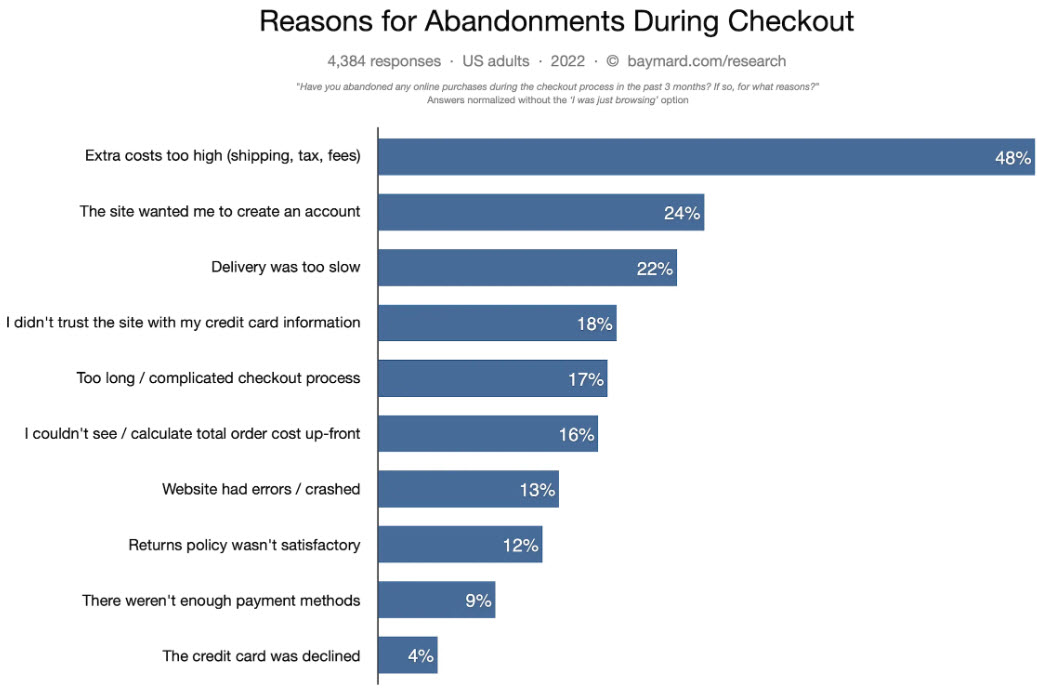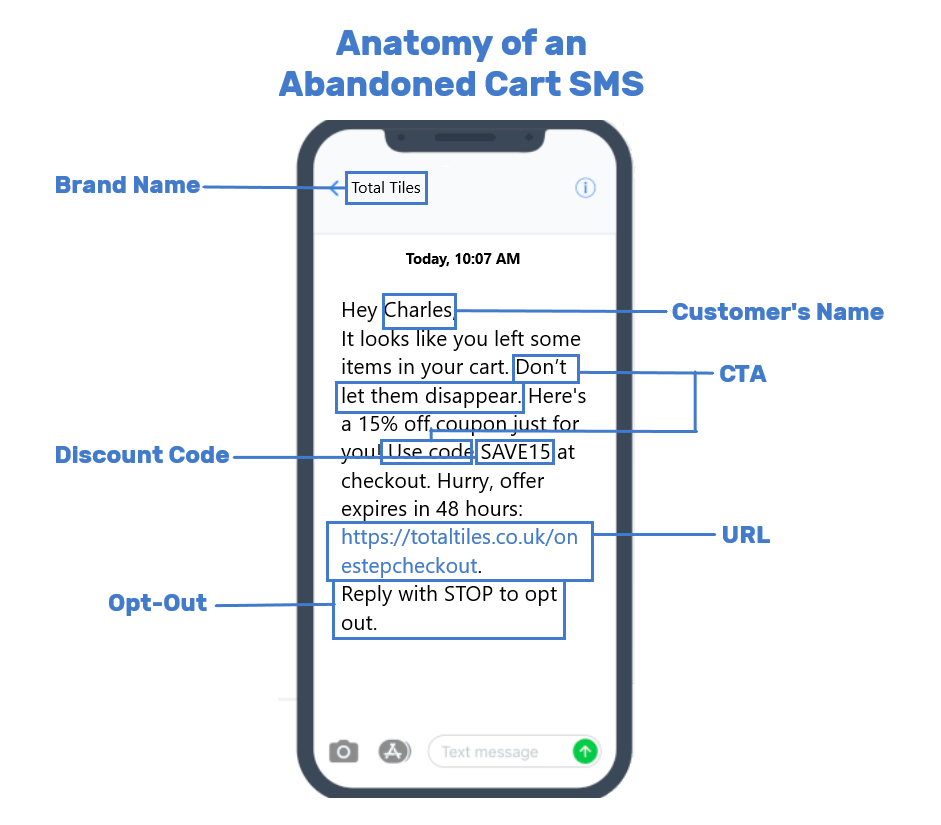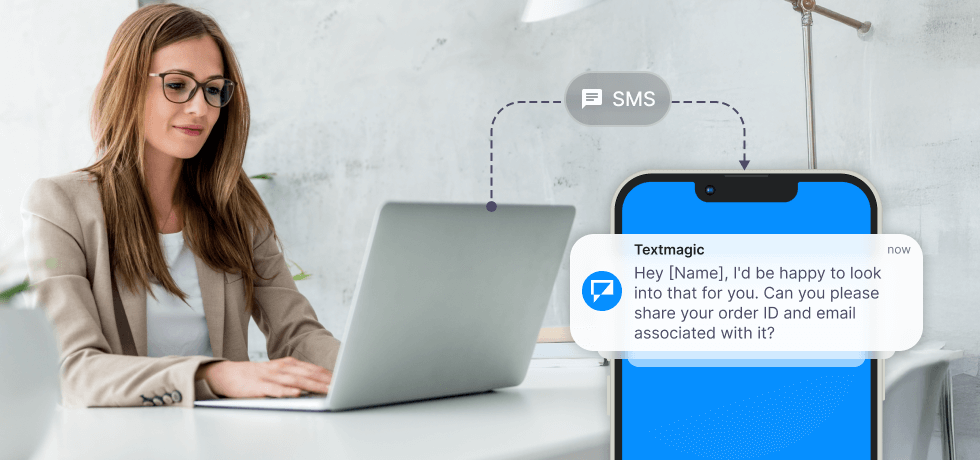
Cart abandonment has become one of the common sources of revenue losses, which makes it vital to address the issue effectively. Implementing abandoned cart SMS is a powerful strategy for winning back sales and customers.
With an average rate of 69.99%, cart abandonment resulted in a $417,814.92 loss in revenue for e-commerce brands in the first half of 2022. Using text messages as reminders can go a long way in helping businesses avoid losing sales.
If you’re here, chances are that you’re also struggling to recover the sales lost due to customers leaving without finalizing their purchases. So, read on to learn the best ways to take advantage of abandoned cart SMS.
You’ll also find the most effective strategies to achieve success by sending potential buyers the right message at the right moment. In addition, we’ve collected ready-to-fill-in examples of abandoned cart SMS. You can easily copy, paste, and use them for your campaigns.
Let’s get started by discussing why customers leave their carts in the first place.
Reasons for cart abandonment
In the fast-paced world of online shopping, cart abandonment remains a significant challenge for e-commerce businesses. A staggering 48% of customers abandon their carts due to high shipping costs, taxes, and fees.

Here are the various reasons for cart abandonment. So, you can use them to better understand and address the factors that drive potential customers away.
- Forced registration process: Asking users to create an account disrupts the purchase cycle. It deters potential customers by adding an unnecessary step to the shopping experience.
- Unclear and sluggish checkout procedures: Customers seek simplicity and convenience. So, a lengthy, complicated checkout process can lead to cart abandonment.
- Limited payment options: Consumers who discover their preferred option is unavailable are likely to leave.
- Payment security considerations: Buyers may feel uncertain about the safety and security of their financial and personal information.
- Excessive shipping fees: An inflated final total can definitely break the deal.
- Unforeseen charges at checkout: Surprise charges can also make the customer leave without completing their purchase.
- Not working discount code: Not only do non-functional discount codes trigger cart abandonment, but they also impair the overall credibility and customer trust.
- Website crashes: Major performance issues like crashes and errors compromise user experience. They prompt customers to search for a more reliable alternative.
- Products saved for later consideration/comparison: This is the case when customers haven’t made a final purchase decision and need some further thought.
What to include in an abandoned cart SMS
Crafting an effective abandoned cart SMS strategy requires careful consideration of several factors. First of all, SMS messages are inherently concise, and customers expect them to be short and to-the-point. Then, with no visual elements to rely on, the power of your message lies solely in the text.
Let’s discuss the essential elements of an SMS cart recovery message.

- Brand Name: Mention your brand name in the SMS to ensure customers recognize the sender and establish trust.
- Customer’s Name: Personalize the message by including the customer’s name, increasing the likelihood of engagement.
- Discount Code: Offer a small discount code to incentivize customers to complete their purchases.
- CTA: Incorporate a call-to-action to encourage customers to take the desired action.
- URL: Add a direct link to your e-commerce website for a seamless user experience and faster return to the site.
- Opt-Out: Provide an opt-out option, offering transparency and showing respect for customer preferences.
Incorporating these essential elements into your message can significantly improve its effectiveness.
How to recover abandoned carts with text messages [plus examples]
Send customers kind reminders
It’s not uncommon for customers to abandon their shopping carts simply because they’ve forgotten about them. In such situations, a gentle nudge can go a long way in getting them to revisit your site and complete their purchase.
Hey [Customer Name], just a quick reminder that you have some fantastic items waiting in your cart. Don’t miss out – complete your purchase here:[Link]
Provide added value to show your concern and appreciation
As we mentioned above, added costs like shipping fees can be a significant barrier for customers. An effective tactic to entice them to complete their purchase is sweetening the deal with free shipping. Alternatively, you can offer a free gift that makes a good addition to the items in the cart.
This approach demonstrates your concern for your customer’s needs. In addition, you show your appreciation for their interest in your business. Keep your message concise, genuine, and focused on the added value or incentive the customer will receive.
For example, instead of just reminding the customer about their abandoned cart, you could send a message like:
Hi [Customer Name], we noticed you left some items in your cart. As a token of our appreciation, we’re offering you FREE shipping on your order! Complete your purchase now: [Link]
Offer coupons and discounts in your abandoned cart SMS
Understanding the exact reason why a customer abandoned their cart might be challenging. However, providing a benefit in your recovery efforts is a bright and safe way to address the situation.
Offering coupons or discounts can help ease any concerns and create a sense of urgency for potential buyers who may be on the fence. This approach encourages customers to complete their purchases and can significantly boost your conversion rates.
When sending text messages to customers with abandoned carts, include a clear and enticing offer. This could be a percentage discount or a dollar amount off their purchase. The key is to make the offer attractive and time-sensitive to encourage immediate action.
For example, you could send a message like:
Hi [Customer Name], we noticed you left some items in your cart. Here’s a 15% off coupon just for you! Use code SAVE15 at checkout. Hurry, the offer expires in 48 hours: [Link].
Create urgency and use FOMO
The fear of missing out (FOMO) can be a powerful motivator, prompting customers to act quickly to avoid disappointment. To leverage FOMO in your cart abandonment SMS campaigns, consider the following strategies:
- Include a relevant CTA: Use compelling verbs and phrases that encourage immediate action, such as “today,” “now,” or “soon.”
- Emphasize time-sensitive offers: If your message includes a discount code or special promotion, let the recipient know when it expires, creating a sense of urgency and encouraging them to act before the offer is gone.
- Highlight limited stock availability: If the item in the customer’s cart is low in stock, use phrases like “Get it before it sells out” to create a sense of urgency and encourage a quick purchase.
- Mention expiring carts: Let customers know their cart is about to expire, emphasizing that they must act quickly to secure their desired items.
- Share item popularity: Inform customers that the item in their cart is popular and might sell out soon, creating a sense of urgency to complete the purchase.
For example, you could send a message like:
Hi [Customer Name], don’t miss out on the items in your cart! They’re selling fast, and your cart expires in 24 hours. Complete your purchase now and enjoy 10% off with code HURRY10: [Link]
Offer real-time help
A key advantage of SMS as a communication channel is its ability to facilitate real-time conversations. Sometimes, customers abandon their carts due to unanswered questions or concerns about a product. You can address these issues by offering real-time assistance via text message. This way, you’ll provide helpful information and guide customers toward completing their purchases.
For example, your text message could say:
Invite them to ask their questions
Customers may be genuinely interested in a product. However, lingering questions or concerns may prevent them from completing a purchase. To help buyers overcome this hurdle, proactively invite them to ask their questions about the products in their cart. This way, you’ll show your commitment to excellent customer service and willingness to address their concerns.
For example, your text message could say:
Hey [Customer Name], your cart is waiting! Feel free to reply if you need any assistance or have questions about the products. We’re happy to help! Finish your purchase now: [Link]
Strategies for using abandoned cart SMS
Let’s discuss text messaging etiquette and the best practices to follow in creating your SMS campaigns.
Mind the timing and frequency
When it comes to abandoned cart SMS, frequency and timing play a crucial role in driving conversions. Studies have shown that sending a message within an hour of cart abandonment can lead to a 20.3% conversion rate. SMS is particularly well-suited for this purpose due to its immediacy. In fact, 90% of recipients read messages within 3 minutes of receiving them.
To maximize the effectiveness of your abandoned cart recovery SMS campaign, consider the following strategies:
- Leverage SMS immediacy: Capitalize on the immediacy of text messages by sending a reminder soon after the cart is abandoned while the product is still fresh in the customer’s mind.
- Create a follow-up campaign: To increase the chances of success, build a campaign that includes scheduling additional SMS reminders sent every 24 hours.
- Limit the number of messages: Avoid overwhelming your customers with too many reminders. The ideal total number of messages to send is three.
Provide an easy opt-out option
It is essential to acknowledge that not all recipients would appreciate your abandoned cart recovery SMS campaigns. Some may have intentionally abandoned their cart and may wish to opt out from receiving further communications. In these cases, implementing the opt-in and opt-out best practices and providing an easy unsubscribe option is crucial.
For example, you could include a simple opt-out message at the end of your abandoned cart reminder: “If you no longer wish to receive these messages, reply STOP to unsubscribe.”
Keep text messages concise and simple
When crafting abandoned cart recovery SMS messages, it’s essential to keep them focused on the primary objective: encouraging customers to complete their abandoned purchase. Here’s what you need to consider:
- Stay on topic: Avoid pushing other sales agendas or promoting unrelated products in your abandoned cart messages.
- Use clear and concise language: Ensure that your customers can quickly grasp the purpose of your message and the action they should take.
- Get straight to the point: Don’t make shoppers impatient by beating around the bush. Clearly state the purpose of your text message.
Use a clear and straightforward CTA
A clear and straightforward CTA is crucial in crafting effective abandoned cart recovery SMS messages. The goal is to guide customers toward your desired action, such as clicking a link, calling a phone number, or replying to the message.
Here are some tips for creating an impactful CTA for your abandoned cart SMS:
- Be direct: Use concise language and action-oriented verbs, such as “click,” “call,” or “reply,” to guide customers toward the desired action.
- Highlight the CTA: Make your CTA stand out within the text message by placing it on a separate line or using capital letters or punctuation to draw attention to it.
- Provide a clear incentive: Communicate the benefit of taking action, such as a discount, free shipping, or a limited-time offer.
Personalize your messages
Personalized text messages can drive greater customer engagement, resulting in the customers taking action and completing the purchase. Incorporating personalization in your abandoned cart recovery SMS strategy can significantly enhance its effectiveness.
Consider the following strategies to personalize your abandoned cart recovery SMS:
- Segment your audience: Tailor your message based on customer loyalty, age, or location. For instance, you might use different copy for loyal customers than new customers or adjust your messaging to cater to regional preferences.
- Address recipients by name: Using the customer’s name in your message can make them feel more valued and connected to your brand. This personal touch encourages them to take action and complete their purchase.
- Customize offers: Consider offering personalized incentives or discounts based on customer behavior, preferences, or purchase history. This can create a sense of exclusivity, motivating customers to complete their purchases.
Combine text messaging and email efforts
For a higher chance of success in your abandoned cart recovery campaigns, leveraging both email and SMS communication channels is essential. By strategically combining these mediums, you can cater to different customer preferences and maximize the potential of each platform.
Here are some tips to effectively combine email and SMS in your abandoned cart campaigns:
- Coordinate your offers: Ensure consistency in your messaging across both channels. Avoid offering conflicting incentives, such as free shipping in an SMS and a 5% discount in an email. If you want to experiment with different incentives, test them across both platforms.
- Play to the strengths of each channel: Email is suited for longer messages of both text and visuals that customers can revisit at their convenience. At the same time, SMS is ideal for short, time-sensitive messages that demand immediate action.
- Create a multi-channel abandoned cart campaign: For example, after a customer leaves their cart, send an email featuring the product with a discount code valid for a week. As the code is about to expire, send a reminder text message to create a sense of urgency or FOMO.
Full-fledged SMS platforms, such as Textmagic, enable you to easily combine SMS with email through the email-to-SMS feature. The software converts your email into a text message, allowing you to send both emails and SMS fast and easily from one place.
Time to recover abandoned carts and win back your customers
SMS offers a direct and unobtrusive way to remind your potential customers about the purchase they haven’t completed. There are just a few rules you have to follow when crafting your abandoned cart SMS:
- Be kind, helpful, and non-intrusive. Your customers will appreciate the friendly reminder and may be more likely to return and complete their purchase.
- Make sure to include a direct link to the customer’s abandoned cart or checkout page, making it easy for them to return and complete their purchase.
- Provide added value to give customers a reason to return to your site.
- Show genuine concern and appreciation for your customers.
This strategy can help you effectively recover abandoned carts and enhance customer satisfaction in the long run, fostering trust and loyalty with your customers.
Frequently Asked Questions (FAQs)
One way to target abandoned carts is to use business texting platforms like Textmagic to send automated SMS messages that trigger when someone leaves items behind. These messages can include product details, a reminder to check out, and a link back to the cart.
Yes, personalization can improve the performance of abandoned cart messages.
You can use Textmagic’s customizable SMS templates to include the customer’s name and mention the items they left behind.
A lower cart abandonment rate starts with a simplified checkout process, eliminating the need for account creation and minimizing unnecessary steps.
Be upfront about all costs and provide diverse payment options for convenience. Follow up with a well-timed SMS or email reminder. Trust indicators, like payment security badges and clear shipping and return policies, can build customer confidence.
If you’re looking for a free way to send abandoned cart reminders via text, Textmagic can help.
The platform offers a trial that lets you send a limited number of SMS messages, which is great for testing your recovery strategy. You can import cart data, craft personalized messages, and include direct checkout links.
Related articles
20 Email marketing examples to grow your business in 2026
Discover the 20 most effective email marketing examp...
16 Marketing ideas for small business that work like a charm
Marketing ideas for small businesses are often the m...
SMS geofencing: What it is and how does it work
Geofencing is one of the latest technological advanc...
40 Christmas text message templates and tips for businesses
The holiday season is the perfect time to connect wi...
SMS for customer service: 7 Tips to delight customers
Flawless customer service is essential in this crowd...




